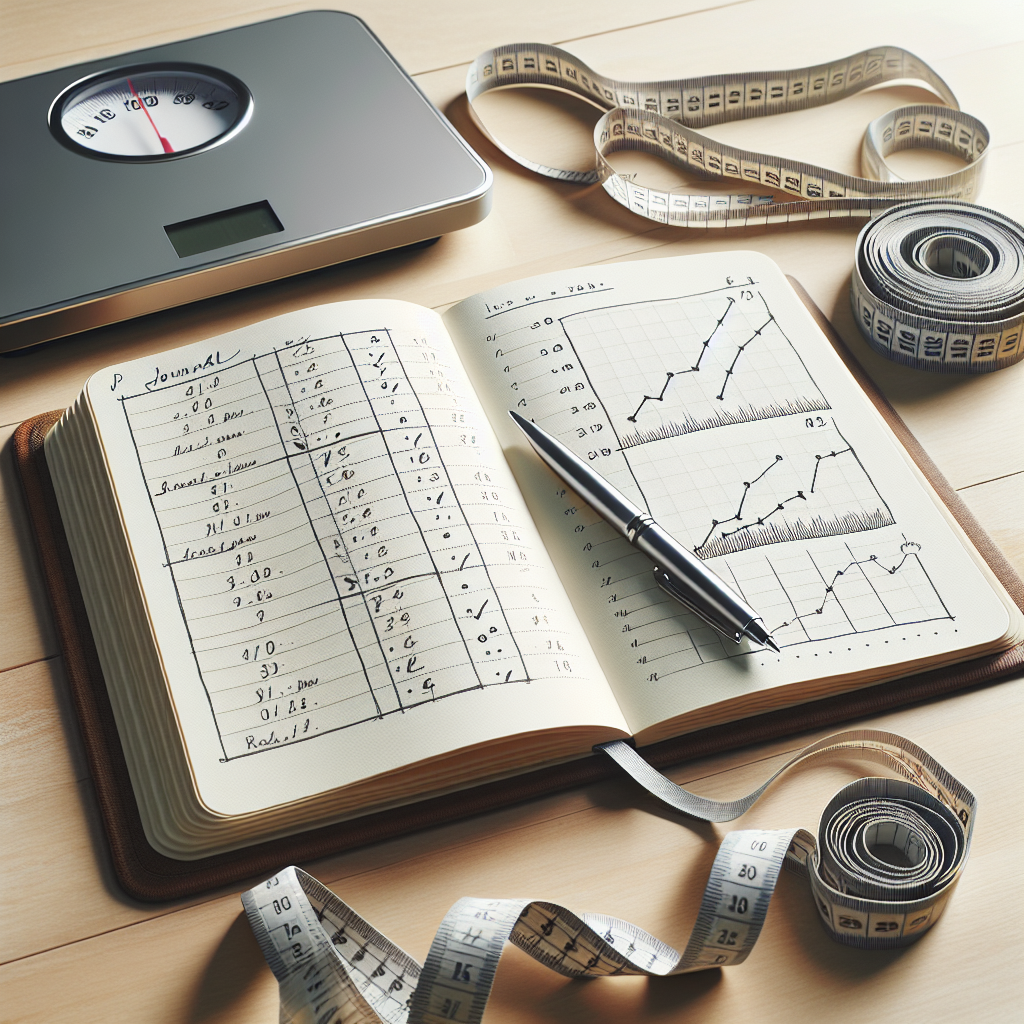How to Effectively Track Weight Loss in a Journal
embarking on a weight loss journey can seem daunting, but it doesn’t have to be. Turn to a tool you probably have lying around the house – a humble journal. Tracking your progress in a journal can provide invaluable insights into your habits, make you more accountable, and bring you closer to your weight loss goals. In “How to Effectively Track Weight Loss in a Journal,” you’ll discover the simple yet effective strategies you can employ to map out your journey and witness tangible progress within a week. Get ready to take control of your health and fitness like never before.

Understanding the Importance of a Weight Loss Journal
a weight loss journal is a beneficial tool that can assist you in your journey to reach your desired fitness goals. This useful companion can provide you with valuable insights, keep you accountable, and be a source of inspiration.
Why keeping a weight loss journal is crucial
The core advantage of a weight loss journal is that it helps to maintain an organized and systematic record of your weight loss journey. It is more than just a collection of numbers or a calorie tracking tool. It stands as a representation of your efforts, providing an instant overview of your daily choices. It helps you understand the relationship between your behaviors, your feelings and your weight loss progress.
Benefits of documenting your weight loss journey
Using a weight loss journal brings numerous advantages. Firstly, it can help you identify patterns or trends in your eating, exercise, mood, and weight. It can serve as a strong motivator by documenting your victories, no matter how minor they may seem. It can act as a guide towards understanding what techniques are working best for you. Overall, a weight loss journal serves as a personalized roadmap during your weight loss journey.
How tracking your progress aids in goal achievement
A well-maintained weight loss journal lets you visualize your progress. You are able to witness firsthand how small alterations in your routine can positively affect your weight loss journey. When you track your progress, you’re giving yourself the opportunity to celebrate your accomplishments, keep momentum and stay focused on your long-term goal.
Choosing the Right Journal for Weight Loss
When you’re ready to start Your weight loss journal, it’s essential to choose a method that clicks with you. There’s no “one size fits all” journal, so it’s all about finding what works for you.
Considerations when selecting a weight loss journal
When choosing a weight loss journal, consider factors like how much space you want for daily entries, whether you want a physical or digital journal, and what kind of tracking system you prefer, such as writing, drawings, checklists, or even diagrams.
Physical vs digital journal: Weighing the pros and cons
While a physical journal can feel more personal and tangible, a digital journal offers convenience, mobility, and the ability to effortlessly edit entries. Both have their strengths, so it all boils down to personal preference.
Features to look for in a weight loss journal
Some beneficial features to consider in a journal include sections for meal and exercise tracking, space for reflecting on your day, and areas to write down your progress and goals. A good weight loss journal should also have room for your thoughts and feelings, as emotional wellbeing is a vital part of the weight loss journey.

Deciding What to Track in Your Journal
Determining what elements to track is crucial as it helps you understand your patterns better. Along with the common elements like meals, exercise, and weight, tracking additional details can provide a holistic picture of your journey.
Essential components to record daily
You should aim to record your daily calorie intake, the type of exercises performed, your weight, and any changes in your measurements.
Additional details you may choose to track
In addition to this, you can choose to track water intake, sleep patterns, stress levels, and even how your clothes are fitting.
Why tracking emotions and mood is beneficial
Your emotional state can significantly influence your eating and exercise habits. Hence, tracking your mood and emotions can help you understand your triggers and handle your challenges more effectively.
Getting Started With Your Weight Loss Journal
Starting a weight loss journal can be exciting and a bit daunting, but preparation and consistency can make it an enjoyable process.
Preparing for your first journal entry
You should start by listing your goals, clocking your starting weight, and defining what elements you’ll track daily.
Designing a consistent journal format
A consistent format makes it easier to track progress over time. This could include sections for meal, exercise, and emotions each day..
Establishing a helpful journaling routine
Creating a routine to update your journal such as shortly after meals and exercise or at the end of each day can help you maintain the consistency required to meet your goals.

Recording Your Daily Food Intake
Accurate documentation of your daily food intake plays a crucial role in your weight loss journey.
How to accurately track what you eat
Record every meal, snack, and beverage consumed during the day. Quantity matters, so keep note of portion sizes as well.
The role of portion sizes and nutrition in weight loss
Understanding portion sizes can help control calorie intake. Noting nutritional data will help you make healthier food choices.
The importance of honesty in food tracking
Honest food tracking can help you pinpoint obstacles that are slowing down your weight loss progress and guide you towards healthier practices.
Logging Your Exercise and Activity Levels
Keeping track of physical activities is just as important as logging your food intake.
Effective ways to document your workouts
Besides the type of exercise, record the duration, intensity, and how you felt during and after the workout.
Recording non-exercise physical activity
Other activities like walking the dog or gardening also contribute to your overall fitness, so include them in your journal.
Linking physical activity to weight loss progress
Maintaining a record of your exercise routine helps you correlate your level of physical activity with weight loss, and adjust your regimen as required.

Tracking Your Body Measurements
Along with body weight, charting your body measurements can give you a better sense of how your body is changing.
How to measure your body for weight loss tracking
Regularly measure areas like your waist, hips, chest, thighs, and arms for a more detailed picture of body transformation.
Why you should record body measurements
Body measurements can often show progress even when your weight remains unchanged. This can keep motivation high in the face of plateaus.
Interpreting changes in body measurements
Reduction in inches can be a sign of body fat reduction and muscle tone improvement.
Recording Weight Loss Progress Over Time
Tracking your weight loss over time gives you a clear image of how far you’ve come and where you need to adjust your strategies.
Why consistency matters in weighing
Regular weigh-ins, preferably at the same time of day, minimize variables and show a more accurate reflection of your actual weight loss.
Monitoring weight fluctuations
Weight can fluctitate daily due to several factors. Recognizing these fluctuations can prevent discouragement and help maintain perspective.
Interpreting and managing weight loss plateaus
don’t get disheartened by plateaus. They are normal and can be overcome by reviewing and adjusting your plan.
Reflecting on and Adjusting Your Weight Loss Plan
Taking time to reflect on your journey and making adjustments allows your weight loss plan to evolve effectively with your progress.
Reviewing patterns and trends in your journal
Identify patterns related to your meal times, choices, workout schedules, or moods that might be affecting your weight loss.
Making adjustments based on your records
Your journal can highlight areas for improvement. Maybe you need more vegetables in your diet or to increase workout intensity.
Using setbacks as opportunities for adjustments
Don’t view setbacks as failures. Use them to reassess, learn, and improve your weight loss plan.
Staying Motivated with Your Weight Loss Journal
Your weight loss journal can play a primary role in keeping you motivated as it records your triumphs, milestones and efforts.
Rewarding yourself for meeting milestones
Rewarding yourself for achieving mini-goals builds positive reinforcement. Treat yourself to something non-food related that you enjoy.
Using your journal as a source of motivation
Your journal serves as a reminder of how far you’ve come, rekindling your motivation during low periods.
Dealing with challenges and setbacks in your journey
Remember, plateauing or having occasional setbacks are part of the journey. Your journal can help you spot these hurdles and navigate around them.
By embracing the discipline of maintaining a weight loss journal and genuinely reflecting on your entries, you can make this tool a powerful ally in your quest for better health.

